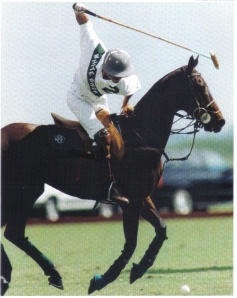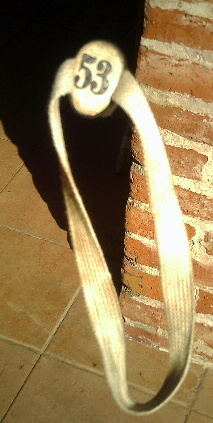First, let me preface this by saying that there are many ways to hit a ball. As long as they work, they are ALL correct. There are simply different styles. When you ask a polo pro to show you how to hit a ball, he typically will show you an Offside Forward Shot in slow motion, with a long follow-through. If you observe him hitting in a game situation, you will never see that demonstated shot. His first question for you should be, “What kind of shot do you want to see?”There are four basic shots, each with 3 variations, giving you, in total, 12 basic shots.
In addition, a basic shot may vary depending upon its purpose. For an example, on an Offside Forehand shot, hit directly ahead, do you want to pass to a team-mate, do you want to hit a guarded penalty shot, do you want to hit far downfield, or what? Those require different types of hits, based on distance and trajectory. The only safe answer from the pro, when asked, “How do you hit a ball?” should be “With the mallethead.” And even then there are exceptions!
I have always maintained that the measure of success of a well hit ball is whether or not the ball “springs” or “jumps” from the mallethead. A solid sound of the ball does not ensure that the full energy has been effectively transferred into the ball. An efficacious transfer of energy into the ball will not necessarily leave the ball deformed by numerous hits. These balls were hit hard, but not necessairly far. Rhythm in a swing is more important than muscle.
Before you get started with hitting, you will want to warm up first. Whether you are mounted on a horse, or standing on a raised platform, or just using a foot mallet, this warm up phase is essential.
First, loosen up by swinging the mallet backwards and forwards, ROTATING YOUR WRIST. When the mallet is back, the palm of your hand should be facing out to the right, not downwards. At the bottom of the swing the palm should face forwards, and when the mallet reaches its furthest point forward, the palm should face to your left, not upwards. Feel the weight of the mallethead during the swing. Let that weight, or pull, work for you. Don’t try to initiate the force by using more muscle. WORK WITH THE WEIGHT OF THE MALLETHEAD.
All this will have the effect of loosening up your muscles, especially in the wrist and forearm. You will understand why this is important in a moment.
Next, place the mallethead on the ground to the side of you. This is where you will be contacting the ball. Notice where your hand is in relationship to your leg or boot. Also, notice where your head is and how high or low it is to the ground and in relationship to the horse. You will need this information later. Do this every time you mount a new horse, because the distances are apt to change. In fact, you might need to adjust these two heights when you are hitting on a galloping horse, because horses run in different manners, some higher or lower.
Since most of your forward shots will be on the Offside (Right Side), and I am assuming that you want to go forward most of the time, we might as well start with the OFFSIDE FOREHAND SHOT

Cambiaso Offside Forward Shot (Notice how Cambiaso has pivoted his hips sideways allowing his shoulders to turn vertically, his head is already down, and his arm is not yet fully extended. Click on the picture for a closeup.)
But first, let us take a look at how a beginner hits a polo ball.
Beginners
– Have a death grip, i.e., they hold the mallet very tightly
– Position their body facing straight ahead throughout the shot
– Have their palm downwards all through the swing
– Dip their head downwards during the swing
– Use a lifting motion to muscle the swing
– Have no twirl in their follow-through
Some polo pros advocate placing the hand up first, extending the arm out straight, turning, then lowering the left shoulder. Some also stress a long follow through, even to the point of extending the arm forward with the palm up. Watching high goal players in slow motion or in segments will evince that these tips are at odds with the styles of the best polo players.
Here are TWO ways to hit your Offside Forhand Shot, depending it you hit with a HARD or SOFT style.
1. HARD STYLE
DROP EXTEND
To hit this HARD style, as you approach the ball, FALL FORWARD and to the right side of your horse, bending at the waist, so that your torso and your head go down.
EXTEND your right hand, reaching WAY BACK and upwards.
With your upper body down, try to push your LEFT SHOULDER to the right, which will allow you to raise your hand even further upwards.
When the time comes to hit, pull your arm downward with your right shoulder, dragging the mallet behind you, keeping your head steady and looking forward.
Try not to force your hand further forward than the contact point of the ball.
The centrifugal force will carry the arm and mallet forward into your follow through.
Don’t overthink.
This is the easiest method to learn, but it is not the easiest for a soft stylist.
2. SOFT STYLE
PIVOT BEND EXTEND
We have all heard that you need to get your shoulders turned so that they are in line with the horse’s spine. If you turn your shoulders as most novices do, you will feel a tension in the shoulders, because your lower body it still facing ahead. You may even take this as a good sign, believing you have coiled your shoulders like a spring, and that will add power. You would be mistaken. Any tension or cramping in your swing will inhibit the body to perform to its optimum level. Instead, try PIVOTING at the waist to turn sideways. This will bring your shoulders around and the shoulders will stay relaxed. By pivoting at the hips, you will also be opening the right knee outwards and locking the left knee into the saddle, automatically. You needn’t be thinking about the “brace” position or locking the knee inward. It will automatically happen if you pivot at the waist.
Next, and almost at the same time that you pivot, BEND downwards from the hip until your head reaches the desired level. Remember warming up and checking your reach and head level? This is why you did that.
Now, when you EXTEND or reach your arm back and upwards, your shoulders will come into play. They will be rotating more on a vertical level, instead of a horizontal turn. Had you stayed up in the saddle and turned before bending, your shoulders would have rotated horizontal to the ground. This is not as effective as having the shoulders move in a vertical motion.
Here is where we will try something different that what you have probably learned. Most pros tell you to sweep through the shot, making sure that you have a nice, long follow through. I would like you to try something else.
HIT WITH THE BUTT CAP
To start your swing, using a very supple wrist and grip, cock your wrist back as opposed to laying the wrist back, either after a preliminary rotation of the arm or simply out of your ready position which is with the stick held upright.
Pivot at the hips slightly, bring your head down somewhat, and extend your hand back and upwards.
As you extend your hand back, your shoulders will turn until they are parallel with the spine of your horse.
Your hand will be just slightly to the right of the horse’s flank.
That means there will be a broken line, one from your left sholder to your right shoulder, and another from your right shoulder to your hand.
TRY NOT TO SHOVE YOUR HAND BEHIND YOUR RIGHT SHOULDER.
Instead, keep the right hand in front of your body.
THE BUTT CAP
 Now lead with the BUTTCAP of the mallet towards the ball, allowing your cocked wrist to keep the mallethead up as long as possible during the swing.
Now lead with the BUTTCAP of the mallet towards the ball, allowing your cocked wrist to keep the mallethead up as long as possible during the swing.
STOP your arm at the bottom of your swing.
Some of you with a stronger forearm or a stronger wrist might initiate the downward swing with a wrist movement to start the mallethead moving. This is an early uncocking of the wrist. It will put additional strain on your wrist without resulting in a further hit.
Don’t just aim at the ball. Aim at the bottom of the ball or under the equator of the ball.
HOW DO YOU HIT DOWNWARDS?
Just tug the BUTT CAP down towards the ball with a short pull.
DON’T TRY TO SWEEP THE ARM THROUGH THE BALL.
DON’T KEEP PULLING THE ARM DOWN TO THE BALL.
DON’T TRY TO TURN YOUR SHOULDERS INTO THE SHOT.
KEEP YOUR HEAD STEADY THROUGHOUT THE SWING.
Pull with a short motion, just with your hand, IN A DIRECT LINE to the ball.
This may give you a feeling of pulling against the mallethead and its weight.
DON’T try to use a circular motion with your hand or your arm, coming around in a path to the ball.
REMEMBER: Use a short tug. Nothing more.
As you stop your arm at the bottom of the swing, a peculiar thing will happen. You won’t be able to actually stop your swing. There is too much weight in the mallet to allow you to do so. Instead, the mallethead will be shot or slung forward, much in the way a catapult works. The weight of the mallet will pull your arm forward and upwards, if you allow your arm to relax right as you strike the ball (or even a slight bit before that), and you cannot help but have a relaxed follow through.
A NOTE ON THE FOLLOW THROUGH
Never intentionally strive for a follow through. After all, your desire is to HIT THE BALL WELL, not just to look good doing so. A follow through is nothing more than the gradual dispersion of energy. If you have done everything correctly up until the contact of the ball, your follow through will occur automatically. The follow through is only an indication that you have done everything right. It should not be your goal.
REMEMBER
Beginners swing with a lifting motion
More experienced players swing the mallet forward in a sweeping motion
Hitters hit DOWNWARDS and STOP at the bottom. The follow through is unavoidable

